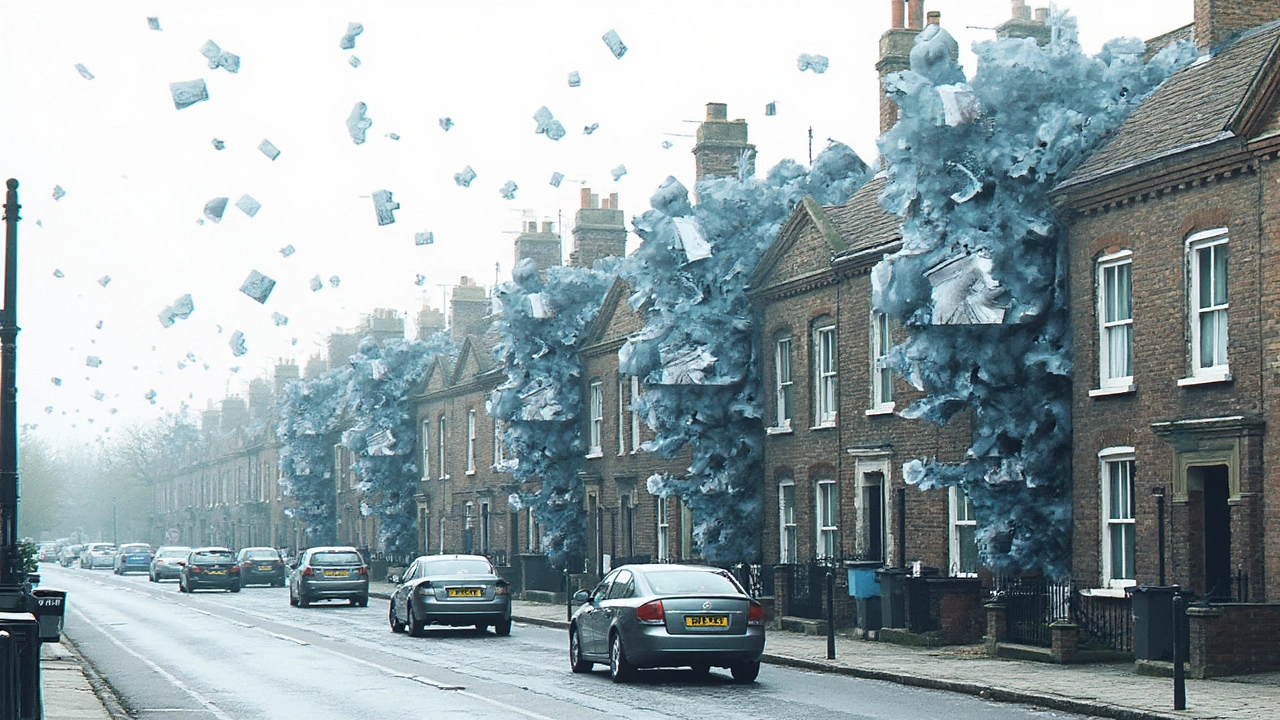Feeling the pinch on your home insurance bill? You're not alone. Costs are climbing, leaving many scratching their heads and wallets. What's happening?
One big reason is the rise in natural disasters. Floods, wildfires, hurricanes—these events are becoming more frequent and severe. Insurers are paying out more in claims, and that means premiums are going up.
But it’s not just the weather. The cost of building materials and labor is increasing too. If it costs more to repair or rebuild a home, your insurance company will want to charge you more to cover that potential expense.
So, what can you do about it? First, shop around. Comparing quotes from different companies can help you find a better deal. Another tip is to improve your home’s security systems. Insurers often give discounts for homes with alarm systems or updated locks.
- Rising Costs: What’s Behind the Hike?
- The Climate Connection
- Construction and Repair Costs
- Smart Ways to Reduce Your Premium
- Keeping Coverage Affordable
Rising Costs: What’s Behind the Hike?
Ever wonder why your home insurance bill seems to be on a permanent upward climb? There’s a blend of reasons, and understanding them might help make it feel a bit less mysterious.
Influence of Extreme Weather
Climate change is a major culprit. Think about it—every flood, wildfire, or hurricane causes massive damage. The more often these events occur, the more money insurance companies have to fork out in claims, which in turn impacts your premiums. After all, they need to balance their books somehow.The Cost of Building and Repairs
Not only are the weather and natural disasters a factor, but the everyday cost of repairing or rebuilding homes plays a part too. Prices for building materials have spiked in recent years, thanks in part to supply chain issues and inflation. So when the cost of repairs goes up, so do your insurance rates.Increased Home Values
More people investing in home improvements? That adds value to houses, which means insurance needs to cover even higher costs to replace or repair them. It’s no wonder those premiums keep climbing.Lastly, don’t overlook the rise in general claim frequencies. When claims go up, insurers see more risk, and that usually translates to higher costs to you.
All these factors combine to create a storm of increased expenses. It's not just one thing, but a mix that makes buying home insurance today a pricier affair than ever before.
The Climate Connection
Ever wondered why you hear so much about climate change when it comes to home insurance? It's because the weather really is playing tricks on us, and not in a good way.
Take hurricanes, for example. They've become more intense over the past few decades. This means more damage in coastal areas, and less stability for the insurance companies that have to foot the bill. The fear of these events has pushed insurers to hike up the premiums to prepare for future claims.
And it's not just about wind and water damage. Rising temperatures are making wildfires more frequent and fierce, especially in places like California and Australia. Homes in these areas are at a higher risk, causing insurance costs to soar.
Rising costs are also partly due to increased flooding. More rainfalls are causing flood zones to expand. This isn't just bad news for those who live near rivers. Urban areas are also affected as outdated drainage systems struggle to cope with the water.
Costly Impact of Weather Patterns
In Europe, storms and unpredictable weather have kept the insurance industry on its toes. A notable example was when Storm Ciara battered parts of the UK and Ireland, causing damages worth billions. These incidents hit insurers hard, spiraling insurance costs.
So, what's the takeaway? If you live in an area prone to these natural phenomena, respective insurers assess risk based on these climate factors. Awareness of your region’s vulnerability helps you plan and perhaps invest in protective measures like flood barriers or fire-resistant building materials.
| Weather Event | Example Impact |
|---|---|
| Hurricanes | Increased premiums in coastal areas |
| Wildfires | Higher costs in fire-prone regions |
| Flooding | Expanded flood zones impacting urban premiums |
| Storms | Billions in damages across Europe |

Construction and Repair Costs
The cost to repair or rebuild your home has been creeping up, and it's taking a toll on your home insurance premiums. Why? Well, a lot of it has to do with what's happening in the construction industry. Let's dive in.
First off, prices for building materials have shot up. Lumber, steel, and even concrete have all become pricier over the past few years. For instance, the price of lumber skyrocketed more than 200% during the pandemic, and while it has come down a bit, it's still higher than pre-pandemic levels. These hikes directly affect how much insurance you'll need to cover potential rebuilds.
Labor costs play a big role too. There’s a demand for skilled workers, but there's a shortage of them. This results in higher wages, which in turn, jacks up your repair bills. Insurers know this and adjust their rates accordingly.
But don't worry, there are some ways around this. To lower your insurance costs, consider these tips:
- Regular maintenance can prevent bigger, costly repairs.
- Keep your home's value up-to-date in your policy to avoid over-or under-insuring.
- Up your deductible, if feasible; it can lower your premiums significantly.
With these strategies, you can help keep your home insurance costs down, even when construction and repair expenses are on the rise.
Smart Ways to Reduce Your Premium
Feeling overwhelmed by rising insurance premiums? You're in luck because there are several strategies you can try to lower your home insurance costs. This section will walk you through practical steps you can take to save without compromising your coverage.
Boost Your Home Security
One of the easiest ways to cut down your premiums is by enhancing your home security. Installing alarm systems, smoke detectors, and deadbolt locks is a wise move. Insurance companies like peace of mind and often reward it with discounts. Plus, smart home devices like security cameras can add an extra layer of protection.
Combine Policies
Ever heard of bundling? It's not just for fast food combos. If you have car insurance, consider getting it from the same provider as your home insurance. Bundling policies can land you significant discounts on your overall insurance costs.
Adjust Your Coverage
Look carefully at your policy. Are you paying for things you don't need? Seaside coverage in the middle of Dublin is probably not necessary. Tailor your policy to match only what you truly require and cut out the rest.
Increase Your Deductible
Is your deductible super low? While it's nice to have small out-of-pocket expenses in case of minor claims, increasing your deductible could lead to lower premiums. Just make sure you can afford the deductible if you ever need to make a claim.
Regular Policy Review
Life changes, and so do your insurance needs. Review your policy annually to ensure it still makes sense. If you’ve made home renovations that improve safety, report those to your insurer. They might result in a rate reduction.
By following these tips, you’re not only making your insurance more affordable, but you're also leveling up your knowledge of how insurance companies think. Always a good idea when dealing with such a crucial investment.

Keeping Coverage Affordable
Thinking your home insurance is costing an arm and a leg? You're not wrong, but there are ways to keep things in check without sacrificing the protection you need.
Review and Adjust Your Coverage
First up, take a good, hard look at your home insurance policy. It’s not just about having coverage; it’s about having the right coverage. Make sure you're not over-insured. Do you really need to cover luxury items? Adjust your plans to match your actual needs, not hypothetical worst-case scenarios.
Increase Your Deductible
Another way to see some savings is by increasing your deductible. This means you’ll pay more out-of-pocket if something happens, but less in premiums. A higher deductible could knock 15% or more off your bill. Just make sure you have enough in the bank to cover that deductible should the need arise.
Improve Home Safety to Earn Discounts
Looking for discounts? Improve your home's security. Insurance companies often provide discounts for installing smoke detectors, alarm systems, or deadbolt locks. Bundling your home insurance with other policies like auto insurance can also save you some cash.
| Security Measure | Potential Discount |
|---|---|
| Smoke Detectors | 5% |
| Alarm Systems | 10% |
| Deadbolts | 2% |
Stay Loyal, But Don't Be Afraid to Switch
Loyalty can also pay off. Some insurers reward long-term customers with lower rates. However, don't get too comfortable. Shopping around every couple of years ensures you’re getting the best deal. Compare quotes and negotiate with your current provider armed with better offers from competitors.
Regular Maintenance Pays Off
Keeping your home in good shape isn't just about avoiding repairs. Regular maintenance like checking for leaks or trimming trees can prevent claims, which in turn keeps premiums lower. A claim-free history is appealing to insurers and might help snag you a better rate.
By strategically adjusting coverage and scouting for discounts, you can keep your home protected and your wallet happy. Remember, it’s about finding that sweet spot between adequate protection and reasonable costs.
